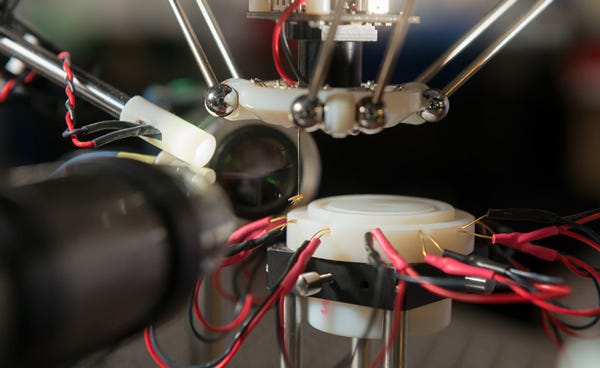July 1, 2015
Robots are increasingly becoming faster, smarter, cheaper, and more dexterous--holding great promise for surgical robotics and medical device manufacturing in the process.
Chris Newmarker
Updated July 6, 2015
|
The robot's suction tube is able to pick up a fruit fly unharmed. (Picture courtesy of Stanford University) |
Stanford University researchers have designed a robot able to perform an especially complex task: catching and releasing fruit flies.
The Stanford robot's fly-catching abilities is but one of a number of recent robot dexterity feats, including a recent YouTube video that showed an Intuitive Surgical (Mountain View, CA) da Vinci robot suturing a grape.
Don't think the Stanford robot is merely the most expensive way to protect bananas in the kitchen, either. Parsing through anesthetized flies in a dish has been one of the most tedious tasks that biomedical researchers have had to engage in over the decades, Stanford researchers explain in a recent news release.
Not only does the robot free up time for graduate students to do science, but it also opens the door for behavioral research with the flies. Over the decades, fruit flies have provided insights on everything from the way radiation causes gene mutations to human beings' own daily sleep/waking rhythms.
"Robotic technology offers a new prospect for automated experiments and enables fly researchers to do several things they couldn't do previously," said Mark Schnitzer, an associate professor of biology and of applied physics. "For example, it can do studies with large numbers of flies inspected in very precise ways."
The robot's fly catching enabled Stanford researchers to study 1000 flies in 10 hours, something that would have taken much longer for even a highly skilled human fly minder.
The robot looks a lot like a UFO hovering over a plate of flies. When it is time to grab a fly, the robot flashes a blast of infrared light that is invisible to the flies; the reflection off the insects' thoraxes indicates the location of each fly on the dish without affecting the behavior of the flies. A tiny suction tube from the robot then strikes one of the illuminated thoraxes, sucking onto the fly and lifting it up while leaving the fly unharmed.
The robot can then study the fly before releasing it. Its machine vision is able to study a fly's physical attributes, sort flies by sex, and even reveal a fly's tiny brain through microdissection. In one experiment, Stanford researchers were even able to use the robot to differentiate between two strains of flies that are indistinguishable to the human eye.
Refresh your medical device industry knowledge at MEDevice San Diego, September 1-2, 2015. |
Chris Newmarker is senior editor of Qmed and MPMN. Follow him on Twitter at @newmarker.
Like what you're reading? Subscribe to our daily e-newsletter.
About the Author(s)
You May Also Like



